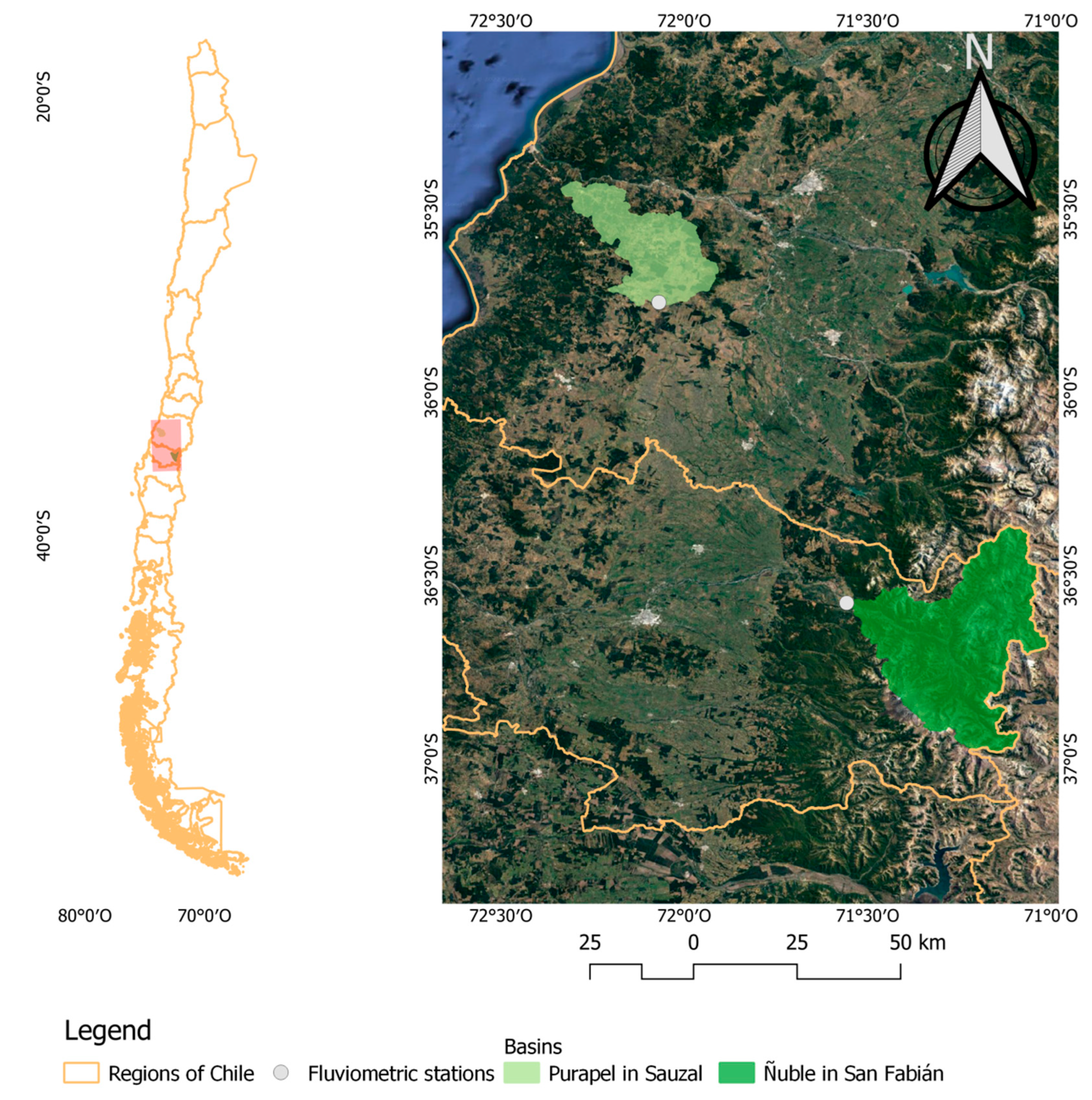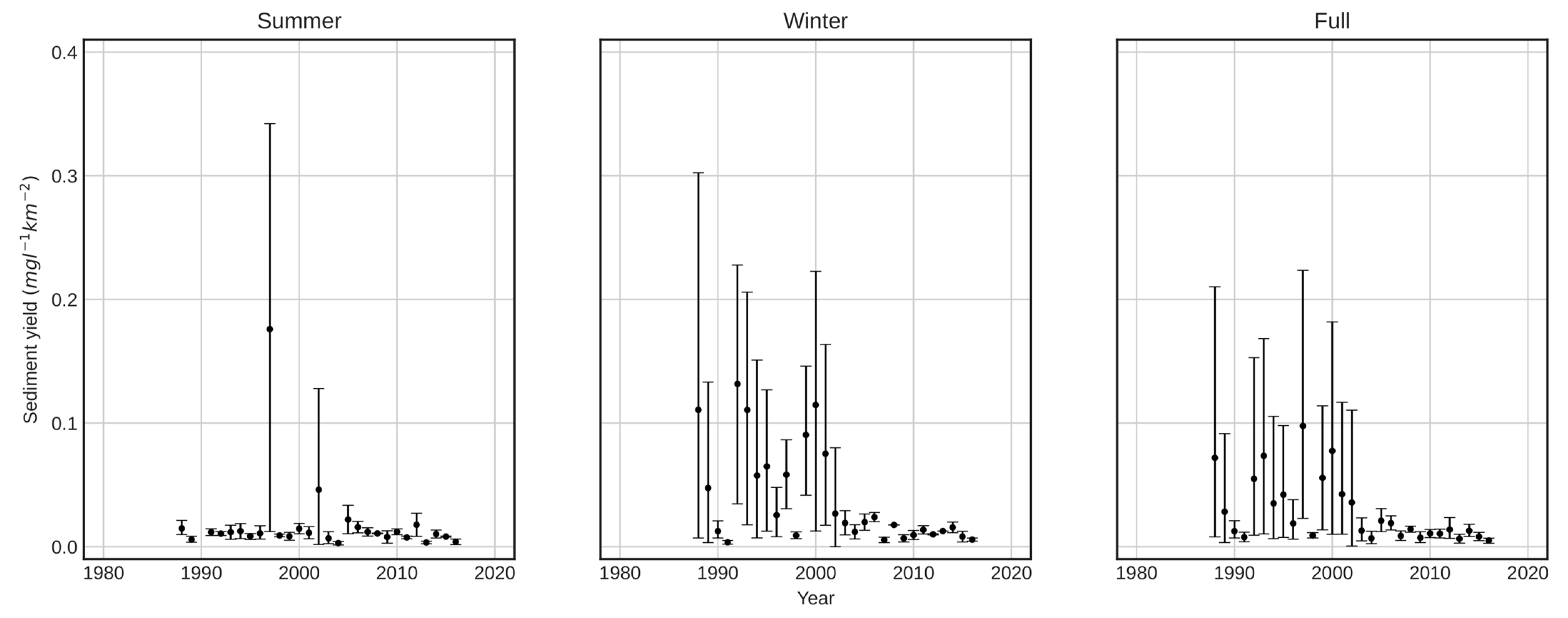Establishment of Monterrey Pine (Pinus radiata) Plantations and Their Effects on Seasonal Sediment Yield in Central Chile
Abstract
:1. Introduction
2. Materials and Methods
Statistical Analysis
3. Results
4. Discussion
5. Conclusions and Recommendations
Author Contributions
Funding
Institutional Review Board Statement
Informed Consent Statement
Data Availability Statement
Acknowledgments
Conflicts of Interest
References
- Rodríguez-Blanco, M.L.; Taboada-Castro, M.M.; Palleiro, L.; Taboada-Castro, M.T. Temporal Changes in Suspended Sediment Transport in an Atlantic Catchment, NW Spain. Geomorphology 2010, 123, 181–188. [Google Scholar] [CrossRef]
- Bezak, N.; Mikoš, M.; Šraj, M. Trivariate Frequency Analyses of Peak Discharge, Hydrograph Volume and Suspended Sediment Concentration Data Using Copulas. Water Resour. Manag. 2014, 28, 2195–2212. [Google Scholar] [CrossRef]
- Sinshaw, B.G.; Belete, A.M.; Mekonen, B.M.; Wubetu, T.G.; Anley, T.L.; Alamneh, W.D.; Atinkut, H.B.; Gelaye, A.A.; Bilkew, T.; Tefera, A.K.; et al. Watershed-Based Soil Erosion and Sediment Yield Modeling in the Rib Watershed of the Upper Blue Nile Basin, Ethiopia. Energy Nexus 2021, 3, 100023. [Google Scholar] [CrossRef]
- Vercruysse, K.; Grabowski, R.C.; Rickson, R.J. Suspended Sediment Transport Dynamics in Rivers: Multi-Scale Drivers of Temporal Variation. Earth-Sci. Rev. 2017, 166, 38–52. [Google Scholar] [CrossRef]
- Sadeghi, S.H.; Singh, V.P. Dynamics of Suspended Sediment Concentration, Flow Discharge and Sediment Particle Size Interdependency to Identify Sediment Source. J. Hydrol. 2017, 554, 100–110. [Google Scholar] [CrossRef]
- Bagio, B.; Bertol, I.; Wolschick, N.H.; Schneiders, D.; do Nascimento dos Santos, M.A. Water Erosion in Different Slope Lengths on Bare Soil. Rev. Bras. Ciênc. Solo 2017, 41. [Google Scholar] [CrossRef]
- Wang, J.; Lu, P.; Valente, D.; Petrosillo, I.; Babu, S.; Xu, S.; Li, C.; Huang, D.; Liu, M. Analysis of Soil Erosion Characteristics in Small Watershed of the Loess Tableland Plateau of China. Ecol. Indic. 2022, 137, 108765. [Google Scholar] [CrossRef]
- Kemp, D.B.; Sadler, P.M.; Vanacker, V. The Human Impact on North American Erosion, Sediment Transfer, and Storage in a Geologic Context. Nat. Commun. 2020, 11, 6012. [Google Scholar] [CrossRef]
- Zhang, J.; Zhang, X.; Li, R.; Chen, L.; Lin, P. Did Streamflow or Suspended Sediment Concentration Changes Reduce Sediment Load in the Middle Reaches of the Yellow River? J. Hydrol. 2017, 546, 357–369. [Google Scholar] [CrossRef]
- Zheng, H.; Miao, C.; Jiao, J.; Borthwick, A.G.L. Complex Relationships between Water Discharge and Sediment Concentration across the Loess Plateau, China. J. Hydrol. 2021, 596, 126078. [Google Scholar] [CrossRef]
- Iradukunda, P.; Bwambale, E. Reservoir Sedimentation and Its Effect on Storage Capacity—A Case Study of Murera Reservoir, Kenya. Cogent Eng. 2021, 8, 1917329. [Google Scholar] [CrossRef]
- Warrick, J.A.; Madej, M.A.; Goñi, M.A.; Wheatcroft, R.A. Trends in the Suspended-Sediment Yields of Coastal Rivers of Northern California, 1955–2010. J. Hydrol. 2013, 489, 108–123. [Google Scholar] [CrossRef]
- Warrick, J.A. Trend Analyses with River Sediment Rating Curves. Hydrol. Process. 2015, 29, 936–949. [Google Scholar] [CrossRef]
- MOP; DITUC. Análisis Crítico de La Red de Sedimentos de La DGA; Dirección General de Aguas: Santiago, Chile, 2020; p. 102. [Google Scholar]
- UNESCO. Antecedentes de La Relación Masa Forestal y Disponibilidad Hídrica En Chile; UNESCO: Montevideo, Uruguay, 2019. [Google Scholar]
- Pizarro, R.; García-Chevesich, P.; Pino, J.; Ibáñez, A.; Pérez, F.; Flores, J.P.; Sharp, J.O.; Ingram, B.; Mendoza, R.; Neary, D.G.; et al. Stabilization of Stage–Discharge Curves Following the Establishment of Forest Plantations: Implications for Sediment Production. River Res. Appl. 2020, 36, 1828–1837. [Google Scholar] [CrossRef]
- Iroume, A.; Huber, A. Intercepción de Las Lluvias Por La Cubierta de Bosques y Efecto En Los Caudales de Crecida En Una Cuenca Experimental En Malalcahuello, IX Región, Chile. Bosque 2000, 21, 45–56. [Google Scholar] [CrossRef]
- Telles, T.S.; Guimarães, M.d.F.; Dechen, S.C.F. The Costs of Soil Erosion. Rev. Bras. Ciênc. Solo 2011, 35, 287–298. [Google Scholar] [CrossRef]
- García-Chevesich, P.A. Control de la Erosión y Recuperación de Suelos Degradados; Outskirts Press: Parker, CO, USA, 2015; ISBN 978-1-4787-4510-5. [Google Scholar]
- FAO. Forests and Water: A Thematic Study Prepared in the Framework of the Global Forest Resources Assessment 2005; FAO forestry paper; Food and Agriculture Organization of the United Nations: Rome, Italy, 2008; ISBN 978-92-5-106090-2. [Google Scholar]
- Oyarzún, C.E.; Frêne, C.; Lacrampe, G.; Huber, A.; Hervé, P. Propiedades Hidrológicas Del Suelo y Exportación de Sedimentos En Dos Microcuencas de La Cordillera de La Costa En El Sur de Chile Con Diferente Cobertura Vegetal. Bosque Valdivia 2011, 32, 10–19. [Google Scholar] [CrossRef]
- Chirino, E.; Bonet, A.; Bellot, J.; Sánchez, J.R. Effects of 30-Year-Old Aleppo Pine Plantations on Runoff, Soil Erosion, and Plant Diversity in a Semi-Arid Landscape in South Eastern Spain. CATENA 2006, 65, 19–29. [Google Scholar] [CrossRef]
- Padilha, J.; Bertol, I.; Magro, B.A.; Bagio, B.; Marioti, J.; Ramos, J.C. Water erosion under three tillage methods in a cultivation of eucalyptus benthamii. Rev. Árvore 2018, 41, e410606. [Google Scholar] [CrossRef]
- Barrett, B.S.; Hameed, S. Seasonal Variability in Precipitation in Central and Southern Chile: Modulation by the South Pacific High. J. Clim. 2017, 30, 55–69. [Google Scholar] [CrossRef]
- Chander, G.; Markham, B.L.; Helder, D.L. Summary of Current Radiometric Calibration Coefficients for Landsat MSS, TM, ETM+, and EO-1 ALI Sensors. Remote Sens. Environ. 2009, 113, 893–903. [Google Scholar] [CrossRef]
- Hantson, S.; Chuvieco, E. Evaluation of Different Topographic Correction Methods for Landsat Imagery. Int. J. Appl. Earth Obs. Geoinf. 2011, 13, 691–700. [Google Scholar] [CrossRef]
- QGIS Development Team. QGIS Geographic Information System. 2022. Available online: https://qgis.org/en/site/ (accessed on 12 December 2022).
- Ahmad, I.; Tang, D.; Wang, T.; Wang, M.; Wagan, B. Precipitation Trends over Time Using Mann-Kendall and Spearman’s Rho Tests in Swat River Basin, Pakistan. Adv. Meteorol. 2015, 2015, 1–15. [Google Scholar] [CrossRef]
- Hu, Z.; Liu, S.; Zhong, G.; Lin, H.; Zhou, Z. Modified Mann-Kendall Trend Test for Hydrological Time Series under the Scaling Hypothesis and Its Application. Hydrol. Sci. J. 2020, 65, 2419–2438. [Google Scholar] [CrossRef]
- Yue, S.; Pilon, P.; Cavadias, G. Power of the Mann–Kendall and Spearman’s Rho Tests for Detecting Monotonic Trends in Hydrological Series. J. Hydrol. 2002, 259, 254–271. [Google Scholar] [CrossRef]
- Sernageomin. Mapa Geológico de Chile: Versión Digital [1:1,000,000]; Servicio Nacional de Geología y Minería, Publicación Geológica Digital: Santiago, Chile, 2003.
- FAO. Metodología Provisional para la Evaluación de la Degradación de Los Suelos; Organización de las Naciones Unidas para la Agricultura y la Alimentación: Roma, Italy, 1980; ISBN 978-92-5-300869-8. [Google Scholar]
- Sangüesa, C.; Rivera, D.; Pizarro, R.; García-Chevesich, P.; Ibáñez, A.; Pino, J. Spatial and Temporal Behavior of Annual Maximum Sub-Hourly Rainfall Intensities from 15-Minute to 24-Hour Durations in Central Chile. Aqua-LAC 2021, 13, 143–156. [Google Scholar] [CrossRef]
- Pepin, E.; Carretier, S.; Guyot, J.L.; Escobar, F. Specific Suspended Sediment Yields of the Andean Rivers of Chile and Their Relationship to Climate, Slope and Vegetation. Hydrol. Sci. J. 2010, 55, 1190–1205. [Google Scholar] [CrossRef]
- Rius, R.; Batalla, R.; Poch, R. Monitoring Water and Sediment Yield In Mediterranean Mountainous Watersheds: Preliminary Results. In Proceedings of the 10th International Soil Conservation Organization Meeting, West Lafeyette, IN, USA, 24–29 January 2001; pp. 223–228. [Google Scholar]
- Abdelwahab, O.M.M.; Bisantino, T.; Milillo, F.; Gentile, F. Runoff and Sediment Yield Modeling in a Medium-Size Mediterranean Watershed. J. Agric. Eng. 2013, 44, 31–40. [Google Scholar] [CrossRef]
- Spalevic, V.; Barovic, G.; Vujacic, D.; Curovic, M.; Behzadfar, M.; Djurovic, N.; Dudic, B.; Billi, P. The Impact of Land Use Changes on Soil Erosion in the River Basin of Miocki Potok, Montenegro. Water 2020, 12, 2973. [Google Scholar] [CrossRef]
- Duran-Llacer, I.; Munizaga, J.; Arumí, J.; Ruybal, C.; Aguayo, M.; Sáez-Carrillo, K.; Arriagada, L.; Rojas, O. Lessons to Be Learned: Groundwater Depletion in Chile’s Ligua and Petorca Watersheds through an Interdisciplinary Approach. Water 2020, 12, 2446. [Google Scholar] [CrossRef]
- Peña-Angulo, D.; Nadal-Romero, E.; González-Hidalgo, J.C.; Albaladejo, J.; Andreu, V.; Bagarello, V.; Barhi, H.; Batalla, R.J.; Bernal, S.; Bienes, R.; et al. Spatial Variability of the Relationships of Runoff and Sediment Yield with Weather Types throughout the Mediterranean Basin. J. Hydrol. 2019, 571, 390–405. [Google Scholar] [CrossRef]





| Basin | Mean Slope (%) | Mean Elevation (masl) |
|---|---|---|
| Purapel | 15.6 | 763.4 |
| Ñuble | 48.8 | 1596.2 |
| Type of Cover | Purapel Basin | Ñuble Basin | ||||||
|---|---|---|---|---|---|---|---|---|
| 1986 | 1997 | 2009 | 2016 | 1986 | 1997 | 2008 | 2015 | |
| Native Forest | 7.9 | 1.6 | 2.6 | 10.3 | 22.4 | 44.2 | 42.9 | 41.8 |
| Plantations | 23.4 | 42.1 | 55.1 | 58.5 | 0 | 0.1 | 0.3 | 0.2 |
| Agricultural Use | 0 | 9.2 | 8.7 | 7.7 | 0 | 1.3 | 0.7 | 0.6 |
| Mixed forest | 0 | 0.6 | 3.5 | 2.7 | 0 | 0 | 0 | 0 |
| Other Uses | 68.7 | 46.5 | 30.1 | 20.8 | 77.5 | 54.4 | 56.1 | 57.3 |
| Purapel | Ñuble | ||
|---|---|---|---|
| Parent Material | Area (%) | Parent Material | Area (%) |
| Plutonic | 52.9 | Plutonic | 17.9 |
| Volcanic | 17.7 | Volcanic | 21 |
| Metamorphic | 29.1 | Sedimentary continental | 4.7 |
| Sedimentary marine and transitional | 0.3 | Sedimentary volcanic | 56.4 |
| Basin | Period | Average Sediment Yield (mg L−1) | Average Streamflow (m3 s−1) | Average Sediment Yield (mg L−1 km−2) |
|---|---|---|---|---|
| Purapel | Summer | 10.992 | 1.801 | 0.017 |
| Winter | 29.752 | 5.876 | 0.045 | |
| Annual | 21.534 | 4.163 | 0.032 | |
| Ñuble | Summer | 8.337 | 77.065 | 0.005 |
| Winter | 29.823 | 110.074 | 0.018 | |
| Annual | 19.928 | 93.842 | 0.012 |
| Period | Variable | Purapel (Z) | Ñuble (Z) |
|---|---|---|---|
| Summer | Mean Sediment yield | −1.3 | 0.2 |
| Mean Streamflow | −0.7 | −1.7 | |
| Winter | Mean Sediment yield | −3.3 | 1.2 |
| Mean Streamflow | −1.1 | −0.2 | |
| Full | Mean Sediment yield | −3.3 | 0.8 |
| Mean Streamflow | −1.8 | −1.0 | |
| Winter/Summer | Mean Sediment yield | −2.4 | 1.0 |
| Mean Streamflow | −0.7 | 0.5 |
Disclaimer/Publisher’s Note: The statements, opinions and data contained in all publications are solely those of the individual author(s) and contributor(s) and not of MDPI and/or the editor(s). MDPI and/or the editor(s) disclaim responsibility for any injury to people or property resulting from any ideas, methods, instructions or products referred to in the content. |
© 2023 by the authors. Licensee MDPI, Basel, Switzerland. This article is an open access article distributed under the terms and conditions of the Creative Commons Attribution (CC BY) license (https://creativecommons.org/licenses/by/4.0/).
Share and Cite
Pizarro, R.; García-Chevesich, P.; Ingram, B.; Sangüesa, C.; Pino, J.; Ibáñez, A.; Mendoza, R.; Vallejos, C.; Pérez, F.; Flores, J.P.; et al. Establishment of Monterrey Pine (Pinus radiata) Plantations and Their Effects on Seasonal Sediment Yield in Central Chile. Sustainability 2023, 15, 6052. https://doi.org/10.3390/su15076052
Pizarro R, García-Chevesich P, Ingram B, Sangüesa C, Pino J, Ibáñez A, Mendoza R, Vallejos C, Pérez F, Flores JP, et al. Establishment of Monterrey Pine (Pinus radiata) Plantations and Their Effects on Seasonal Sediment Yield in Central Chile. Sustainability. 2023; 15(7):6052. https://doi.org/10.3390/su15076052
Chicago/Turabian StylePizarro, Roberto, Pablo García-Chevesich, Ben Ingram, Claudia Sangüesa, Juan Pino, Alfredo Ibáñez, Romina Mendoza, Carlos Vallejos, Felipe Pérez, Juan Pablo Flores, and et al. 2023. "Establishment of Monterrey Pine (Pinus radiata) Plantations and Their Effects on Seasonal Sediment Yield in Central Chile" Sustainability 15, no. 7: 6052. https://doi.org/10.3390/su15076052
APA StylePizarro, R., García-Chevesich, P., Ingram, B., Sangüesa, C., Pino, J., Ibáñez, A., Mendoza, R., Vallejos, C., Pérez, F., Flores, J. P., Vera, M., Balocchi, F., Bustamante-Ortega, R., & Martínez, G. (2023). Establishment of Monterrey Pine (Pinus radiata) Plantations and Their Effects on Seasonal Sediment Yield in Central Chile. Sustainability, 15(7), 6052. https://doi.org/10.3390/su15076052









